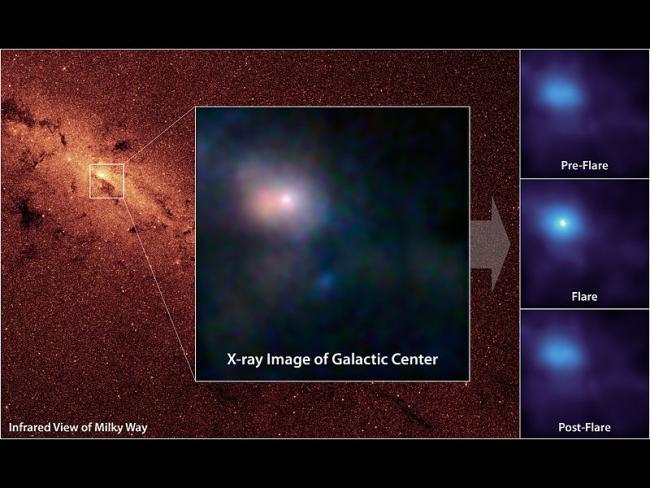
NASA's Nuclear Spectroscopic Telescope Array captured these views of the supermassive black hole at the heart of our galaxy in high-energy X-rays. The background image, taken in infrared light, shows the location of our Milky Way's supermassive black hole. In the main image, the brightest white dot is the hottest material located closest to the black hole, and the surrounding pinkish blob is hot gas, likely belonging to a nearby supernova remnant. The time series at right shows observed flaring at four different X-ray energies. A gas cloud has been spotted approaching the black hole, and new calculations predict that bright radio emission from shocks generated buy this encounter may be detected later this year.
Our Milky Way galaxy has a super-massive black hole at its core, about four million solar-masses in size.
Supermassive black holes of this mass or even thousands of times bigger are found at the nuclei of most galaxies. Black holes, despite their reputation for being implacable sinks for matter and energy, can eject both radiation and matter from their vicinity. Sometimes this outpouring occurs as powerful jets of charged particles, prompted when nearby matter accretes onto to a hot disk around the black hole. In dramatic cases, like quasars for example, nuclear black holes are responsible for some of the most spectacular phenomena in the cosmos, with dramatic jets, flaring, and intense radiation at all wavelengths including X-rays and gamma-rays. The processes take the huge gravitational potential energy of infalling matter and convert it into radiation other forms of energy.
The super-massive black hole at the center of the Milky Way, however, is quiescent. It emits no jets, and matter around the source has been seen only faintly spotted. The larger volume around the black hole, however, is much busier. There are seven bright stars and perhaps a thousand fainter stars orbiting the black hole, along with hot gas and dust. Over the years astronomers have measured the orbital motions of the bright stars to determine the mass of the black hole to a precision of about 10%. About ten years ago scientists noticed what seemed to be a cloud of gas also in orbit near the black hole. Last year they announced that, if their calculations are correct, the gas cloud will approach extremely close to the black hole -- about thirty-six light-hours (about 260 astronomical units) - and will do so sometime later this year! No one knows for sure what will happen, but some dramatic fireworks are expected if the cloud is torn apart by the strong gravitational force of the black hole, or is even eaten.
CfA astronomers Aleksander Sadowski, Ramesh Narayan, Lorenzo Sironi, and Feryal Ozel have performed detailed computations to simulate this coming galactic interaction. In particular, they looked at the shocks likely to develop as the cloud reaches its closest approach, and conclude that intense radio emission from such shocks is likely to develop seven to nine months before the actual moment of closest approach. Although so far no such emission has been spotted, there are considerable uncertainties in the future path of the cloud, in part because its internal structure is very uncertain. Nevertheless, this new paper has encouraged astronomers to keep their eyes peeled; the public is also alerted to stay tuned for exciting developments to come.
"Location of the bow shock ahead of cloud G2 at the Galactic Centre," Aleksander Sadowski, Ramesh Narayan, Lorenzo Sironi, and Feryal Ozel, MNRAS, 433, 2165, 2013.
Projects
AbacusSummit
AstroAI
GMACS
For Scientists